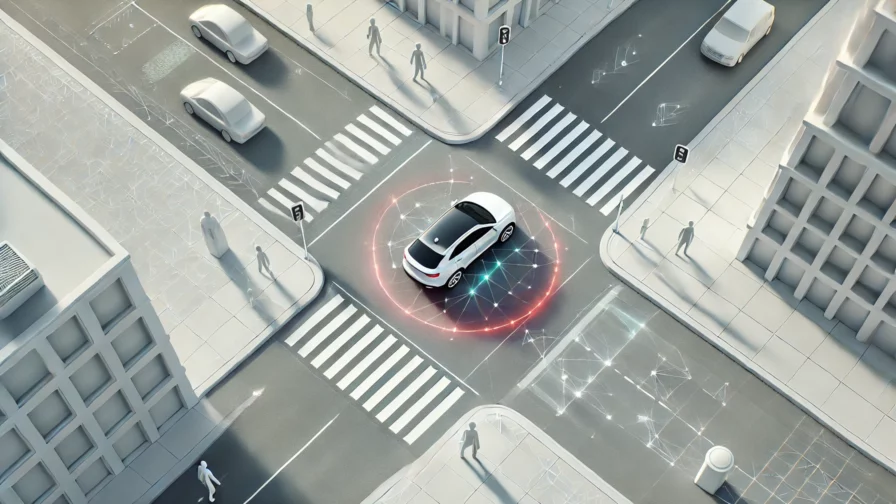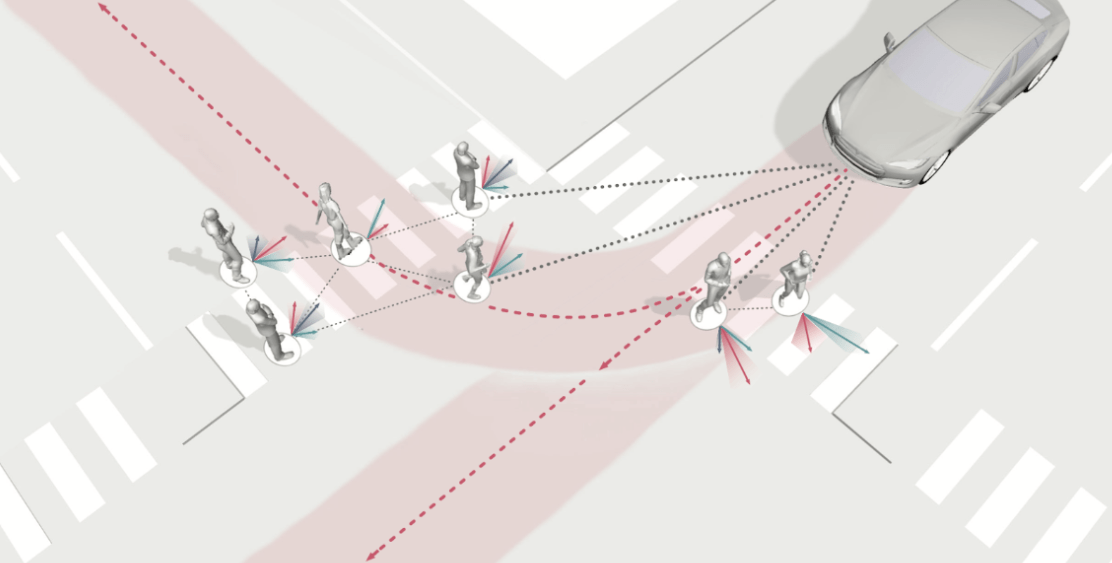
Exploring the role of V2X, predictive models, and human-centered design in road safety applications with Vodafone Automotive.
Authors: Manuel Pernigotto, Luigi Gallo, Alessandro Solinas, Andrea Tuscano
- Introduction
a. What is V2X: Key Concepts and Enabling Technologies
b. The Role of 5G and MEC
c. V2X in Action: Real-World Scenarios - STEP: A Real-World Case Study
- Trajectory Forecasting and Collision Avoidance
- Neuroscience Meets Road Safety
- Conclusion and Practical Takeaways
Introduction
In this article, we’ll explore the foundations of V2X and the enabling technologies behind it. We’ll look at how 5G and MEC provide the low-latency backbone, how platforms such as STEP (Smart Transport Ecosystem Platform) integrate devices and infrastructure, and how trajectory forecasting and collision avoidance algorithms differ from traditional machine learning. Finally, we’ll connect technology with human factors, showing how neuroscience-driven design can make road safety applications more effective and intuitive
What is V2X and Its Enabling Technologies
Vehicle-to-Everything (V2X) enables vehicles to exchange data not only with each other (V2V), but also with infrastructure (V2I), pedestrians (V2P), and networks (V2N), creating a cooperative ecosystem for safer and more efficient mobility.
Two main technologies power V2X in the 5.9 GHz band:
- DSRC (IEEE 802.11p): a Wi-Fi–based standard, tested in pilots, with low latency for short-range communication.
- C-V2X (LTE/5G): supports both direct and network-assisted communication, offering scalability and integration with mobile networks.
While DSRC is simple and mature, C-V2X provides flexibility and a natural path to 5G. In practice, deployments often mix both or transition gradually, depending on regulation and infrastructure maturity.
The Role of 5G and MEC in V2X
While DSRC and C-V2X provide the communication backbone, the real leap forward in V2X comes with 5G and Multi-access Edge Computing (MEC). Together, they unlock the scalability and responsiveness required for next-generation mobility services.
Why 5G matters
5G networks introduce three key improvements over previous cellular generations:
- Ultra-low latency, which is critical for safety applications such as collision warnings and emergency braking.
- High bandwidth, enabling the exchange of large data volumes, including sensor data from LiDAR, cameras, or HD maps.
- Massive device connectivity, which supports dense traffic scenarios where thousands of vehicles and IoT devices coexist.
In practice, 5G allows vehicles not only to “see” their immediate surroundings but also to receive updates from distant sources, such as traffic control centers, cloud services, or other vehicles outside the line of sight.
The role of MEC
Multi-access Edge Computing brings cloud-like processing closer to the user, placing compute resources at the edge of the network (for example, at a base station). This reduces the physical distance data must travel, ensuring real-time responsiveness.
In a road safety context, MEC enables:
- Distributed intelligence: Algorithms can be deployed at the edge, processing data from multiple vehicles before critical decisions are made.
- Context awareness: Localized data (traffic congestion, road hazards, weather conditions) can be processed and shared almost instantly.
- Scalability: By offloading heavy processing from vehicles to the network edge, even resource-constrained devices can participate in advanced cooperative applications.
STEP: A Real-World Case Study
When we talk about V2X, it’s easy to stay at the level of protocols, standards, and theoretical use cases. But what does a real platform that brings all of this together look like? That’s where STEP (Smart Transport Ecosystem Platform) comes in.
What is STEP and why does it matter?
STEP is designed to tackle some of the toughest challenges in connected mobility:
- Interoperability: cars, roadside units, and mobile devices all need to “speak the same language”.
- Scalability: the number of connected vehicles and users is growing fast, and the system must keep up without slowing down.
- Security and privacy: sensitive data like vehicle location and trajectories need strong protection against spoofing, jamming, or unauthorized access.
- Real-time decision support: alerts such as “crossing ahead” or “emergency braking” only make sense if they’re delivered within milliseconds.
STEP addresses these issues by combining edge computing for low-latency, safety-critical tasks with cloud resources for large-scale analytics and coordination with authorities.
The architecture at a glance
The platform can be thought of as four layers:
- Devices and Vehicles: cars, smartphones, and IoT sensors generating data and receiving alerts.
- Edge/MEC (Roadside Units): local computing nodes that process time-sensitive information, for example collision avoidance or cooperative perception.
- Core Cloud: where advanced analytics, orchestration, and long-term storage take place.
- Authorities and Services: traffic managers, emergency services, and public institutions connected via standardized APIs.
Integration in practice
What makes STEP compelling is not just the architecture, but the way it supports integration:
- Standardized message formats (like CAM and DENM from ETSI) ensure different stakeholders can collaborate seamlessly.
- Cooperative services like:
- intersection alerts with limited line of sight,
- updates of local HD maps,
- collaborative trajectory forecasting.
In short, STEP is more than a communication layer. It’s an ecosystem enabler, helping vehicles, users, and infrastructure act as a coordinated network rather than isolated nodes.
Trajectory Forecasting
Trajectory forecasting is the ability to anticipate the future path of a road agent based on current motion and contextual information. By processing inputs such as speed, position, and road geometry, predictive models can estimate how an actor is likely to move over the next seconds. This capability is critical in mixed traffic scenarios, where vehicles, pedestrians, and cyclists interact in complex ways. Rather than relying only on reactive responses, forecasting provides a forward-looking perspective, enabling mobility systems to anticipate risky maneuvers, lane changes, or sudden stops. In the context of V2X, these predictions become much more useful when shared across vehicles and infrastructure, creating a cooperative awareness that extends beyond line of sight.

Collision detection
Collision detection systems are built directly on top of trajectory forecasts, transforming predictions into meaningful safety insights. By analyzing potential intersections of multiple predicted paths they can identify situations where two or more actors may come dangerously close. This process involves calculating predicted proximity between road agents, evaluating relative speeds and angles, and accounting for driver perception. When a possible collision is detected, the system generates a risk index that determines the urgency of intervention. In practice, effective collision detection turns abstract trajectory forecasts into real-time safety mechanisms, enhancing connected mobility and letting us take a step towards reducing accidents on the road.

Neuroscience Meets Road Safety
When we think about road safety apps, we usually focus on the algorithms: how fast can they detect a risk, how accurate are they in forecasting a collision? But neuroscience reminds us that safety doesn’t depend only on detection. It also depends on how human beings perceive, process, and react to notifications in real time.
Why neuroscience matters in V2X notifications
Human decision-making is shaped in milliseconds by attention, emotional responses, and cognitive workload, often before conscious thought kicks in. This means that even the most advanced detection system can fail if the alert is poorly designed, badly timed, or cognitively overwhelming.
A multidisciplinary approach
To bridge these gaps, we combine:
- Neuroscience to understand attention, reaction times, and emotional impact.
- UX/UI design to translate these insights into usable interfaces.
- Neurotesting tools to measure attention and cognitive load.
This integration lets us connect the technical accuracy of cooperative platforms with the human brain’s ability to react under pressure.
From lab insights to real-world design
So far, we’ve tests and prototyping sessions to capture how people expect to interact with safety platforms. These qualitative insights were validated with quantitative models and are now being tested in controlled environments where we can measure real reactions.
Designing an evidence-based communication language
From receiving zero information, to partial information, to complete information, we can design alerts that are optimized for clarity, speed, and safety.
In other words, we are creating a scientifically grounded communication language for cooperative mobility.
The bigger picture
This approach will help developers and designers make evidence-based decisions when building road safety apps. The result: fewer errors, faster reactions, and better protection for vulnerable road users in the connected mobility ecosystem.
Conclusion
V2X is more than a new communication protocol: it’s the foundation for a cooperative mobility ecosystem that blends cutting-edge networks, predictive algorithms, and human-centered design.
For developers, designers, and mobility innovators, the key lesson is clear: technology alone is not enough. Scalability, interoperability, and low latency matter, but so do attention, trust, and cognitive ergonomics. Building safer roads means building systems that people can rely on, understand instantly, and act upon without hesitation.

Key takeaways:
- V2X is an ecosystem, not a single technology—success comes from interoperability across vehicles, infrastructure, and services.
- 5G and MEC unlock real-time safety, by combining bandwidth, ultra-low latency, and localized intelligence.
- STEP shows what’s possible: a platform that integrates cloud and edge to connect vehicles, users, and authorities.
- Predictive models shift mobility from reactive to proactive, anticipating risks before they become accidents.
- Neuroscience keeps humans in the loop, ensuring alerts are designed for clarity, timing, and cognitive efficiency.
By aligning robust technology with human-centered design, we can transform V2X from a promising concept into a daily reality, delivering safer and smarter mobility for everyone.




